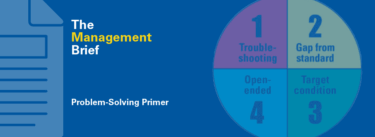“Hey, boss, we’re huslin’ to get this truck worked. It was late…again. And some of my put-away crew couldn’t stay any longer than I had ’em scheduled.”
“Alright. Hey, what’s the deal with that u-boat you got there?”
“Oh, you know, another one with a stuck wheel. I couldn’t find any of the newer ones. They always come up MIA. Ben over there’s just going without one. No big deal though, I’ve got him hunting through piles of backstock anyway.”
“Well, I heard OPEX is working on all of this. We’ll see what they come up with.”
“I’ve heard that before…”
I was reminded recently of this gemba exchange, and the phenomenon of a few big problems distracting us from the multitude of smaller ones, when reading about the current negative outlook of the American Worker (and Out-of-Worker). A woman being interviewed had fallen into an obsessive swirl with one or two massive problems facing the United States. She had become so involved with reading and participating in blogs about these issues that basic problems associated with her family’s quality of life went ignored. For instance, her nearly immobile and severely depressed husband, sitting in the chair next to her, was asking when she’d have time to restock the fridge.
But back to the story…
I had been assigned to create a “model retail store” that would demonstrate a different way to run, manage and improve operations. And in the process, would reveal gaps and contradictions within the company’s “management system.”
The “struggle board” had just gone up. We asked team members to share their struggles by writing them on post-it notes and placing on the board, visible for all to see.
The board generated a flurry of activity for a few days. These team members had never been prompted by “management” to voice their concerns before, not formally anyway. And indeed it appeared they had some concerns.
Some of the struggles that were shared were “need more labor hours” and “product received that was not ordered” and “too many customer questions” and ”too little communication” and “equipment never works” and “mean management” and “this silly struggle board.” On the one hand we were excited (and laughing a little), but on the other we recognized there was little we could do on our own to address these issues. Even something like “equipment never works,” which should only require a call into maintenance, had been tried repeatedly. Maintenance kept repairing the equipment. Yet stubbornly it kept breaking down.
So what to do? The team members had been asked to share. They expected something to happen, to change, to improve. We took a next, albeit indirect, step…
First, we identified key jobs in the area, jobs that directly impacted the customer experience and occurred most often as a factor of sales volume. In other words, jobs that really mattered to customers, team members, and the business.
Then we spent time observing – writing down each job’s steps, measuring time, drawing the work area and station layouts (including tools, supplies and product being worked on), and tracing the walking required to perform these tasks. All this information was displayed on a wall creating what we called a “work story.”
We then started analyzing these jobs, distinguishing between actions, or motions, second-by-second, that transformed the product in some way (value creating) from actions required to enable that transformation (non-value creating) and unnecessary motion, what we labelled as “waste.”
ENGAGING THE TEAM IN THESE SPECIFIC WORK DETAILS – STEPS, STUFF NEEDED, AND TIME – BEGAN CHANGING THE CONVERSATION FROM “THEY NEED TO FIX…” TO “WE COULD TRY…”
For example, we discovered that one job’s cycle time was greater than its rate of customer demand. So, unless something changed, a 2nd worker was needed or customers would continue waiting in queue.
With the facts now available, the team began brainstorming ways to change the story…
“I’m not sure why we keep that tool all the way over there. I mean, it’s only used for this one job. If it were over here that would ELIMINATE some of the walking.”
“And how about if we REARRANGE elements two and three. If three were done before two, wouldn’t two be easier?”
“Step six could be removed, or SUBTRACTED, from the job, while the customer’s waiting anyway, and done beforehand. I bet our customers would appreciate that!”
“You know, and I’ve never thought about this before, but steps four and five could be done simultaneously. In other words, they could be COMBINED. I mean, I have two hands. Why not use them both and grab that tool and that part at the same time?”
“What would really be nice is if the correct sequence of steps were just obvious. I don’t know, but what if we visualized somehow the correct way to do this job, especially since it’s changing now? That could really SIMPLIFY things for us.”
And on, and on, and on.
In problem solving, we’re taught to ask a simple question, “Is this problem within my scope of control?” If yes, then we go after it. If no, then we escalate it to the next level of management. But for that to happen, I’ve learned it’s sometimes necessary to engage frontline team members in thinking about their work (steps, stuff, and time involved for transformation per a customer need) first. Once introduced to these details of work and its inevitable problems, they can engage in making improvements…now. No longer do they feel the need to wait for OPEX.
I wonder about that woman in the article. I imagine her daily actions go largely ignored, much less the relative times involved. That’s certainly been the case for me at times. But like I’ve learned to practice, were she to spend even some of her time reflecting on these things, like the problem of the empty fridge, wouldn’t she, and her country, be better off?






